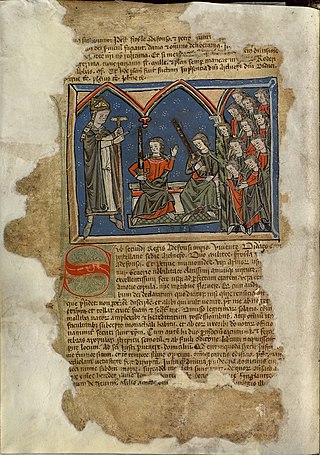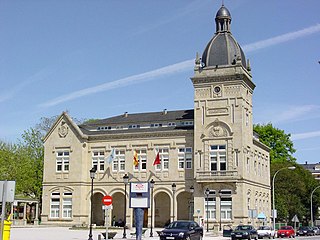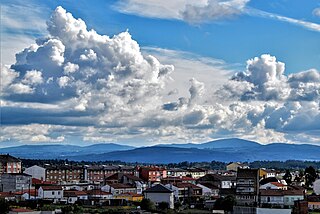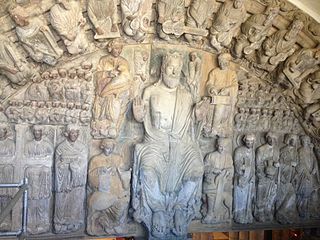
Santiago de Compostela, simply Santiago, or Compostela, is the capital of the autonomous community of Galicia, in northwestern Spain. The city has its origin in the shrine of Saint James the Great, now the Cathedral of Santiago de Compostela, as the destination of the Way of St. James, a leading Catholic pilgrimage route since the 9th century. In 1985, the city's Old Town was designated a UNESCO World Heritage Site.

Andrade is a surname of Galician origin, which emerged in the 12th century as the family name of the knights and lords of the small parish of San Martiño de Andrade, in the municipality of Pontedeume. The first mention of this small territory is to be found in the documentation of the monastery of San Xoán de Caaveiro, and belong chronologically to the 9th century. It was part of the region of Pruzos, which was created as an administrative and ecclesiastical territory of Kingdom of Galicia in the sixth century by King Teodomiro through a document written in Latin called Parrochiale suevum, Parochiale suevorum or Theodomiri Divisio. From the 12th century Pruzos, and therefore Andrade, were integrated into the county of Trastámara that belonged to the lineage Traba, the most powerful Galician family. By this same time the family group: Fortúnez, begins to unite their names Andrade as surname, since in this parish their family home was located. The knights of Andrade were faithful vassals of their lords the Counts of Trastámara throughout the middle centuries of the Middle Ages.

Diego Gelmírez or Xelmírez was the second bishop and first archbishop of the Catholic Archdiocese of Santiago de Compostela in Galicia, modern Spain. He is a prominent figure in the history of Galicia and an important historiographer of the Iberia of his day. Diego involved himself in many quarrels, ecclesiastical and secular, which were recounted in the Historia Compostelana, which covered his episcopacy from 1100 to 1139 and serves as a sort of gesta of the bishop's life.

A Estrada is a municipality in the province of Pontevedra, in the autonomous community of Galicia, Spain. It belongs to the comarca of Tabeirós – Terra de Montes. It is located some 15 miles (24 km) southeast of Santiago de Compostela.

The Diocese of Mondoñedo-Ferrol is a Latin diocese of the Catholic Church in Spain. It is the northernmost of the four suffragan dioceses in the ecclesiastical province of the Metropolitan Archdiocese of Santiago de Compostela, which covers Galicia in the northwest of Spain. The area had previously been home to Britonia, a settlement founded by expatriate Britons in the wake of the Anglo-Saxon invasion of Britain. Britonia was represented by the diocese referred to as Britonensis ecclesia in sources from the 6th and 7th centuries.

The Battle of Clavijo is a battle from the Reconquista period, led by King Ramiro I of Asturias and led by General Sancho Fernández de Tejada against the Muslims. It would have taken place in the so-called Campo de la Matanza, near Clavijo, La Rioja, Spain, dated May 23, 844. Its mythical characteristics, its condition as justification of the Vow of Santiago and the revision that historiographical criticism entailed since the 18th century. From the Najerense Chronicle, Ramiro's campaigns against the Arabs are known, while the chronicles of Abderramán II speak of Moorish campaigns in Álava, but both agree on the strong fights in the Riojan area. More specifically, Asturias sources say that Ordoño I, the son of Ramiro I, surrounded the city of Albelda and established its base on Mount Laturce, that is, the same place where the legend places the battle of Clavijo. And the archaeological findings leave no room for doubt: in Albelda there was a lot of fighting, although news of the supposed battle of Clavijo, supposedly already famous, did not appear in any source until centuries after its supposed date. It is also the historical reference that Enrique IV and later the rest of the monarchs have used for the creation and confirmation of privileges to the Ancient and Illustrious Solar de Tejada, the only manor that has been maintained from then to the present.

The Archdiocese of Santiago de Compostela is a Latin Church archdiocese of the Catholic Church in Spain. It is the senior of the five districts in which the church divides Galicia in North-western Spain.

Melide is a municipality in the province of A Coruña in the autonomous region of Galicia in northwest Spain. It belongs to the comarca of Terra de Melide. It has an area of 101 km2 and a population of 9,000 inhabitants mostly spread among its 26 parishes. It has an elevation of 456 meters.

The Diocese of Palencia is a Latin diocese of the Catholic Church located in the city of Palencia in the ecclesiastical province of Burgos, Spain.

The Diocese of Jaén is a Latin Church diocese of the Catholic Church in the city of Jaén in the ecclesiastical province of Granada in Spain.

The Diocese of Coria-Cáceres is a Latin Church diocese of the Catholic Church located in the cities of Coria and Cáceres in the ecclesiastical province of Mérida–Badajoz in Spain.

The Diocese of Salamanca is a Latin diocese of the Catholic Church located in the city of Salamanca in the ecclesiastical province of Valladolid in Spain.

The Fort of Nossa Senhora da Rocha is a medieval castle situated in the civil parish of Porches, in the municipality of Lagoa in Portuguese Algarve. Inside the fort is the Chapel of Nossa Senhora da Rocha, of uncertain date.

Arias Pérez or Peres was a Galician knight and military leader in the Kingdom of León. According to modern scholar Richard Fletcher, he was "active, resourceful, spirited and persuasive", and the contemporary Historia compostellana says that he was "so eloquent that he could turn black into white and white into black", although he "was not of the great nobility".

Pedro Fróilaz de Traba was the most powerful secular magnate in the Kingdom of Galicia during the first quarter of the twelfth century. According to the Historia compostelana, he was "spirited ... warlike ... of great power ... a man who feared God and hated iniquity," for Diego Gelmírez himself had "fed him, like a spiritual son, with the nutriment of holy teaching." Brought up at the court of the Emperor Alfonso VI, Pedro raised the future Emperor Alfonso VII in his household. Around the latter he and Diego formed a "Galician party" that dominated that region during the turbulent reign of Urraca (1109–26). In September 1111 they even had the child Alfonso crowned king at Santiago de Compostela, but it was Pedro who was imperator in orbe Galletiae.

Rodrigo Pérez de Traba, called el Velloso, was a Galician magnate who rose to prominence after the coronation of Alfonso VII as co-ruler of León in 1111. He served Alfonso at court in his early years, but was given increased responsibility in Galicia after the death of Alfonso's mother, Queen Urraca (1126). After about 1132 he became increasingly involved in the politics of Portugal, whose invasion of Galicia he supported in 1137. Even after León and Portugal made peace in 1141 Rodrigo was largely excluded from Leonese politics, with the notable exception of the military campaigns of 1147, until 1152. Thereafter until his death he was the dominant lay figure in Galicia.

Juan Pardo de Tavera (1472–1545) was a cardinal and was Archbishop of Toledo and Primate of Spain (1534–1545), Grand Inquisitor of Spain (1539–1545), Archbishop of Santiago de Compostela (1524–1534), Bishop of Osma (1523–1524), Bishop of Ciudad Rodrigo (1514–1523) and President of the Royal Council (1524-1539).

Pedro de Deza (1520–1600) was a Spanish Roman Catholic cardinal and bishop.

Pedro Suárez de Deza was a Spanish prelate, the bishop of Salamanca from 1166 until his transfer to the archbishopric of Santiago de Compostela in 1173, where he remained until his death. In 1183 he served as chancellor of the kingdom of León. Of his stature in the Leonese kingdom, Roger Wright claims that he "would probably be now ... widely celebrated ... if he had only had a biographer", like his predecessor, Diego Gelmírez, did.

The Citadel of Pamplona or The New Castle is an old military renaissance fort, constructed between the 16th and 17th centuries in the city of Pamplona, the capital of the Navarre Community (Spain). At present a large part of the fort it is still standing in a public park with cultural activities taking place in its buildings.





















